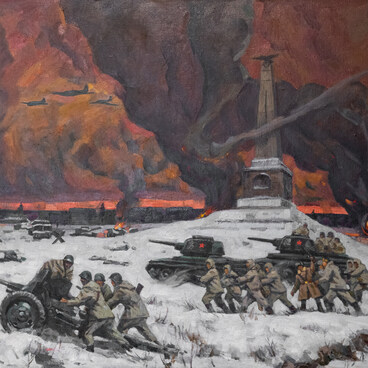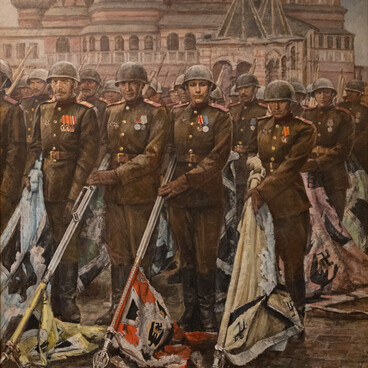The exhibition titled “The Feat of the Army” represents the heroic history of the Great Patriotic War. This painting by the Moscow artist Dmitry Ananiev depicts Pe-2 dive bombers. These bombers were considered to be the best in their class by Soviet pilots and were used for strafing targets on land and at sea. In the five years of the war, over eleven thousand bombers were produced.
The Pe-2 was developed by a team of Soviet engineers led by Vladimir Petlyakov. This aircraft became the most mass-produced Soviet dive bomber. The first planes were adopted into use by the 95th bomber aviation regiment in early 1941. On May 1, the regiment participated in the air parade over Moscow. The first flight of the Pe-2 occurred in late 1939. A year later, mass production of the aircraft was launched.
The pilots and technicians of aviation regiments had mixed feelings about the bomber. On the one hand, it was a modern aircraft with advanced flying characteristics, good equipment, and control mechanization. On the other hand, the bomber was difficult to control, especially at take-off and landing due to the high speed required by the wing profile. With too little speed, the aircraft would often stall and crash. At the same time, the Pe-2 was the first Soviet aircraft to implement electrically actuated systems, including heater shutters, trimming flaps, landing flaps, and other components. All of this required high-quality maintenance operations which were often impossible to provide during the war. It took up to two hours to prepare the aircraft for a flight. At first, it was necessary to supply hot water and heat oil and then to start the engines to let them warm up.
The Pe-2 had two cockpits: one for the pilot and the navigator, and the other for the gunner and radio operator. The bomber had four mounting points for bombs inside the fuselage bay, two bomb bays in the rear of the engine nacelles, and four external racks. The bombs from the external racks were dropped by the pilot, and the internally carried bombs were sent by the navigator. Although the aircraft was initially developed for nose-diving attacks, it was more often used to strafe the targets in flat diving and from a horizontal position. The so-called “Peshka” bombers were used on the frontlines throughout the entire war. They supported the land forces during the Battle of Moscow and the counteroffensive near Kursk. The Pe-2 aircraft was often used to attack targets behind enemy lines to destroy the enemy’s communication and supply routes.
The Pe-2 was developed by a team of Soviet engineers led by Vladimir Petlyakov. This aircraft became the most mass-produced Soviet dive bomber. The first planes were adopted into use by the 95th bomber aviation regiment in early 1941. On May 1, the regiment participated in the air parade over Moscow. The first flight of the Pe-2 occurred in late 1939. A year later, mass production of the aircraft was launched.
The pilots and technicians of aviation regiments had mixed feelings about the bomber. On the one hand, it was a modern aircraft with advanced flying characteristics, good equipment, and control mechanization. On the other hand, the bomber was difficult to control, especially at take-off and landing due to the high speed required by the wing profile. With too little speed, the aircraft would often stall and crash. At the same time, the Pe-2 was the first Soviet aircraft to implement electrically actuated systems, including heater shutters, trimming flaps, landing flaps, and other components. All of this required high-quality maintenance operations which were often impossible to provide during the war. It took up to two hours to prepare the aircraft for a flight. At first, it was necessary to supply hot water and heat oil and then to start the engines to let them warm up.
The Pe-2 had two cockpits: one for the pilot and the navigator, and the other for the gunner and radio operator. The bomber had four mounting points for bombs inside the fuselage bay, two bomb bays in the rear of the engine nacelles, and four external racks. The bombs from the external racks were dropped by the pilot, and the internally carried bombs were sent by the navigator. Although the aircraft was initially developed for nose-diving attacks, it was more often used to strafe the targets in flat diving and from a horizontal position. The so-called “Peshka” bombers were used on the frontlines throughout the entire war. They supported the land forces during the Battle of Moscow and the counteroffensive near Kursk. The Pe-2 aircraft was often used to attack targets behind enemy lines to destroy the enemy’s communication and supply routes.



